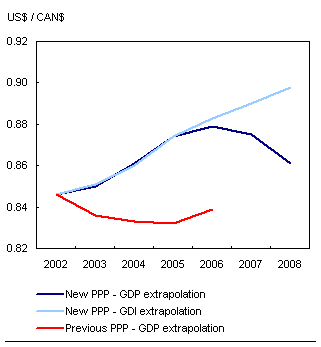Publications
Latest Developments in the Canadian Economic Accounts
New projection methodology for purchasing power parities
Archived Content
Information identified as archived is provided for reference, research or recordkeeping purposes. It is not subject to the Government of Canada Web Standards and has not been altered or updated since it was archived. Please "contact us" to request a format other than those available.
Purchasing power parities (PPPs) are estimates of relative purchasing power between two or more currencies. By adjusting to a common currency and a common set of prices, they can be used to make international comparisons of the relative volumes of goods and services invested in or consumed.
With the latest release of the bilateral PPP estimates for Canada and the U.S., an improved projection methodology for the non-benchmark years has been employed. This note explains the new methodology and its rationale.1
PPP data are typically built up from detailed final demand (i.e. expenditure) categories, with adjustments for inventories to portray the data in terms of gross domestic product (GDP). In nominal terms, GDP equals gross domestic income (GDI), the sum-of-incomes approach to arriving at the same aggregate, and the two terms are often used interchangeably. In real terms, however, there is an important distinction between GDP and GDI which arises primarily from changes in the prices of the commodities a country exports and imports. These terms-of-trade adjustments can affect the relative purchasing power of a country's currency and thus represent real income changes without necessarily directly impacting output.
Previously published data were extrapolated from the benchmark year using the relative movements in the GDP implicit price indexes, which failed to capture the real income changes after 2002. The terms-of-trade adjustments were essentially treated as price changes and thus removed from the real income measure. This approach is better suited to deriving measures intended for productivity comparisons, as opposed to purchasing power. Estimates of PPPs are now extrapolated from the benchmark year using relative movements in real GDI, a more appropriate concept when examining purchasing power.
The difference in the two methodologies lies in the choice of the deflator used for imports and exports. In the past, U.S./Canada bilateral PPP studies typically made use of exchange rates as proxies for net exports. This is primarily because comparative import and export prices are difficult to collect, given that countries do not tend to import and export the same goods and services. However, this approach is not without criticism. It assumes that exchange rate changes are immediately and fully reflected in market prices of traded goods and services, which is not supported by empirical evidence.2 With the new methodology, a PPP aggregate for domestic consumption and investment is now used for the trade balance. This is because a measure of relative domestic prices is more appropriate for use in estimating purchasing power over items bought with the income generated through trade. This is similar to the procedure used in country comparisons for the Penn World Tables3 and is consistent with the calculation of quarterly real GDI for Canada.4
The result is a PPP consistent with the measure of purchasing power for the benchmark year, and should help to minimize future revisions to the data. It more accurately depicts the improvements in Canada's terms of trade since 2002 due to changes in relative prices of exports and imports arising largely from a stronger Canadian dollar vis-à-vis the U.S. dollar.5
In Chart 1, below, it can be seen that the incorporation of benchmark data for 2005 shifted the overall PPP level higher in that year, as compared to previously published data which were the result of an extrapolation using a GDP deflator. The positive trend, which continues with the use of the GDI deflator, reflects the Canadian terms-of-trade improvements since 2002. This increase in purchasing power is not captured in an extrapolation using the relative movements in the Canada/U.S.GDP deflator.
Chart 1: Total purchasing power parities - Alternative extrapolations from 2005
Description for Chart 1

Notes:
- A more detailed article, "Purchasing Power Parities and Real Expenditures, United States and Canada" will be released in early 2010.
- Baldwin, J.R. and B. Yan, 2004, "The Law of One Price: A Canada-U.S. Exploration." 50, 1: 1-10.
- See Deaton, Angus and Heston, Allan," Understanding PPPs and PPP-Based National Accounts", Cambridge, MA; National Bureau of Economic Research, Working Paper 14499, November 2008.
- CANSIM Table 380-0062.
- See Baldwin, John and Macdonald, Ryan, "PPPs - Purchasing Power or Producing Power Parities" (forthcoming) for more detail. Economic Analysis (EA) Research Paper Series. Ottawa: Statistics Canada.
- Date modified:
